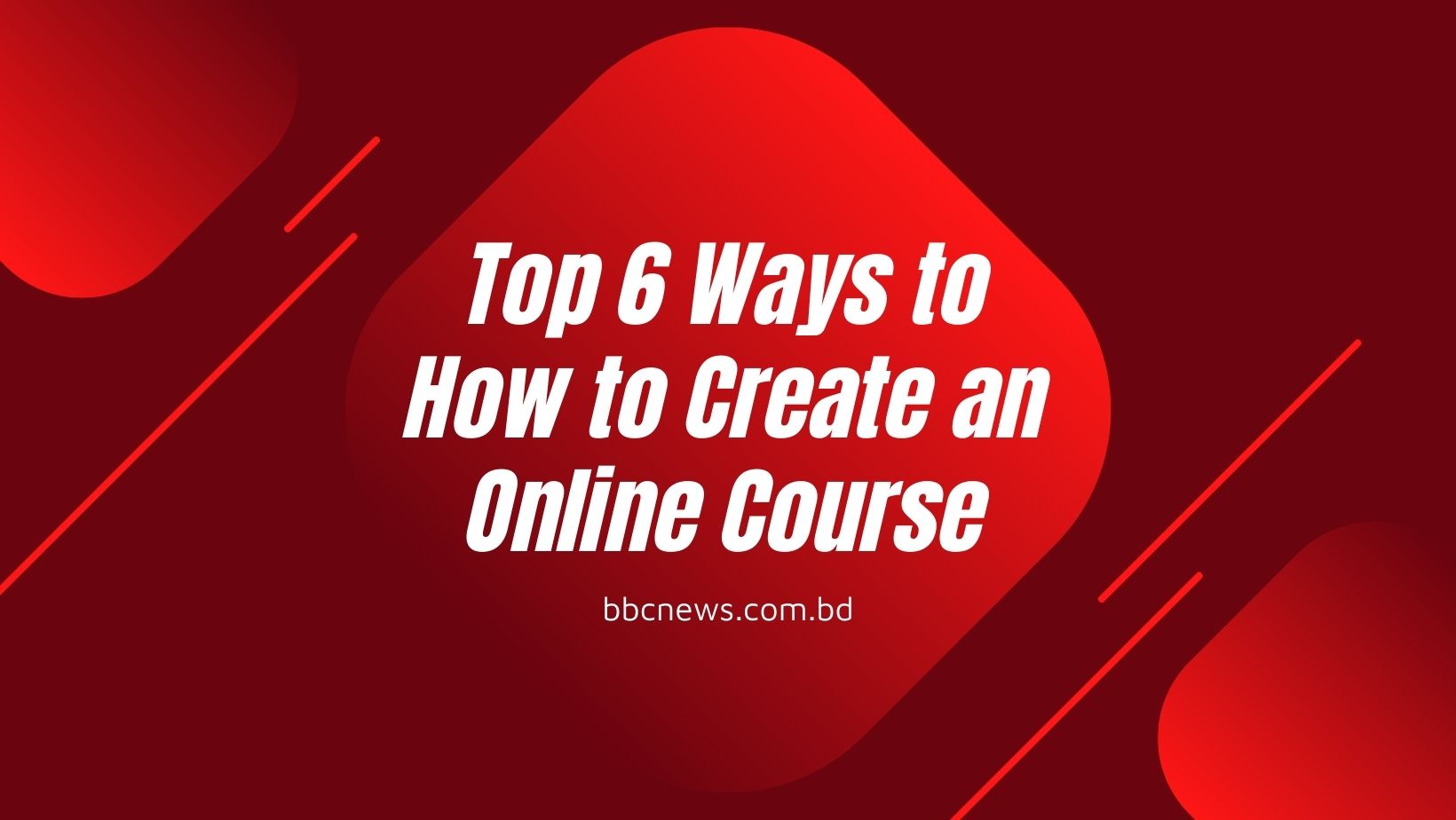Introduction
Have you ever wished you could learn from industry experts without leaving the comfort of your own home? Well, now’s your chance! Creating an online course allows professionals like yourself to share their knowledge and skills with eager learners all across the globe. No matter what field or subject matter you specialize in, this comprehensive guide will walk you through each step of crafting a successful online course that captivates students and leads them toward success. So fasten your seatbelt as we dive into this exhilarating adventure of turning your expertise into an engaging virtual learning experience.
Top 6 Ways to How to Create an Online Course
In this comprehensive guide on creating an online course, we’ll equip you with everything you need: strategies for designing captivating content, tips for effective marketing, and insights into monetizing your efforts like never before.
Get ready to unleash your knowledge worldwide and make a lasting impact in the digital age.
Understanding the Basics
When embarking on your online course journey, it is crucial to understand the subject matter you want to teach clearly. This starts with identifying your expertise and passion. What topics do you feel confident and knowledgeable about? What areas spark excitement and curiosity within you? By aligning your online course with these aspects, you ensure a solid foundation for your teaching and increase the chances of motivating and engaging your students.
However, more than having expertise in a subject is required; understanding the basics of instructional design is equally important. The overall structure, content delivery methods, assessments, and learning objectives are essential in creating an effective online course. Take the time to familiarize yourself with various instructional design models or consult with professionals who can guide you through this process. By grasping these fundamental principles, you are better equipped to organize your thoughts while keeping the learner’s needs and preferences at the forefront.
A deep understanding of your subject matter and instructional design foundations will form the backbone of your online course journey. As Aristotle once said, Educating the mind without educating the heart is no education. So, as you embark on this exciting venture, remember that blending knowledge with passion creates a rich learning experience that will leave a lasting impact on both you as an instructor and your eager students.
Choosing the Right Platform
Selecting the perfect platform to host your online courses is crucial for the success of your e-learning venture. With so many options available, it is important to opt for user-friendly platforms that offer robust features to enhance the learning experience. Platforms like Udemy, Teachable, Sudoksho, and Coursera have gained popularity among course creators due to their easy-to-use interfaces and comprehensive tools.
One such platform that has gained recognition in recent times is Sudoksho. It offers a range of features specifically designed for course creators, such as customizable landing pages, interactive quizzes and assessments, and seamless payment processing. Additionally, Sudoksho provides detailed analytics on student progress and engagement, enabling you to tailor your teaching approach accordingly.
Another popular option is Coursera. Known for its extensive library of courses from top universities and organizations worldwide, Coursera offers an impressive platform that supports multimedia content creation and interactive learning experiences. With a vast community of learners already engaged with the platform, hosting your course on Coursera can enhance its visibility and reach a larger audience.
When choosing a platform for hosting your online courses, prioritize user-friendliness and robust features. Ensure that the chosen platform aligns with your teaching style and allows you to create an engaging experience for your students. Selecting platforms like Udemy, Teachable, Sudoksho & Coursera, which provide various customization options along with their user-friendly interfaces, are most likely to help you thrive as an online.
Designing Engaging Course Content
Now that you clearly understand your course’s objectives and target audience, it’s time to dive into the creative process of developing your content. One key strategy for crafting engaging course content is breaking complex topics into digestible modules. By dividing your course material into smaller, more manageable chunks, you make it easier for learners to grasp the concepts and create a sense of progression and achievement as they progress through each module.
In addition to breaking down complex topics, incorporating multimedia elements can greatly enhance the learning experience. Videos, images, audio clips, or interactive exercises can add variety and appeal to your course content while catering to different learning styles. Visual aids can help clarify concepts that may be difficult to explain in writing alone. Moreover, multimedia elements have been shown to boost learner engagement and retention by providing interactive and immersive experiences.
While designing engaging content is crucial, evaluating its effectiveness is important. Monitoring how learners engage with each module can provide valuable insights into what resonates with them and what may need improvement or further clarification. Incorporating features such as quizzes or assessments at the end of each module allows you to gauge learner progress while offering them an opportunity for self-reflection.
By breaking down complex topics into digestible modules and utilizing multimedia elements effectively, you can create an engaging learning experience that caters to diverse learning preferences and enhances knowledge retention. Constantly evaluating and refining your content based on learner feedback will ensure continuous improvement in crafting effective courses.
Building a Strong Community
Online courses offer a unique opportunity for students to access high-quality education from the comfort of their own homes. However, lacking traditional classroom settings often makes online learning feel isolated and detached. This is where a thriving online course community enhances the learning experience by fostering interaction among learners.
One way to nurture such a community is by integrating discussion forums. These platforms serve as virtual meeting places where learners can engage in thoughtful conversations about course material, share insights and perspectives, and seek help from their peers. By enabling students to connect with others on the same learning journey, discussion forums provide academic support and create a sense of camaraderie and mutual accountability.
In addition to discussion forums, live Q&A sessions further build a strong community within an online course. These interactive sessions allow learners to engage directly with instructors and ask questions in real-time. Providing immediate responses and clarifications, these sessions help address students’ uncertainties or misconceptions while encouraging active participation and engagement. The availability of live Q&A sessions gives students a sense of connectedness during their learning journey, helping them feel supported and cared for by instructors and classmates.
Furthermore, peer-to-peer interactions are integral components of an effective online course community. Collaborative activities such as group projects or peer evaluations encourage students to work together towards common goals while fostering communication skills and promoting a deeper understanding of course concepts. Peer feedback provides alternative viewpoints and encourages critical thinking while building trust
Effective Marketing Strategies
Even the best courses need effective marketing strategies to reach their target audience. Social media platforms are powerful tools for promoting your course and engaging with potential students. Platforms like Facebook, Instagram, and LinkedIn can help you showcase your course content, interact with interested individuals, and build a community around your topic.
Furthermore, email marketing is an excellent way to directly connect with potential students who have expressed interest in your course. Using opt-in forms on your website or landing pages, you can collect email addresses and send targeted emails about your course offering. This allows you to provide valuable information, updates, and incentives to encourage individuals to enroll.
In addition to social media and email marketing, search engine optimization (SEO) is crucial for ensuring that your course appears prominently in search engine results. Optimizing your website’s content with relevant keywords and meta tags will increase its visibility on search engines like Google. By ranking higher on search results pages, you increase the likelihood of attracting organic traffic from users actively searching for courses similar to yours.
Effective marketing strategies are necessary even for the best courses out there. Social media platforms can help create a community around your course, while email marketing enables direct communication with potential students. Lastly, SEO techniques ensure that people searching for relevant topics find your course easily on search engines. Implementing these techniques will not only expand the reach of your course but also attract more interested learners who can benefit from what you have to offer.
Monetizing Your Course
When turning your passion into profit, it’s essential to consider smart monetization strategies. One effective method is offering tiered pricing options for learners. You can cater to a wider range of individuals and their specific needs by providing different packages at various price points.
Tiered pricing allows learners to choose the package that best suits their budget and desired level of engagement. For example, you could offer a basic package with access to your online courses or workshops at a lower price. Then, introduce a mid-tier package with additional resources, such as worksheets or personalized feedback for those seeking more guidance. Finally, create a premium package that offers exclusive one-on-one coaching sessions or access to a private community for deeper support.
This approach provides versatility for different budgets and allows learners the freedom to upgrade or downgrade as they progress in their learning journey. It incentivizes them to invest in themselves while ensuring you generate consistent revenue from your passion. By offering tiered pricing options, you’ll find yourself attracting a wider audience while optimizing profitability in an ever-growing industry. So, start strategizing how to monetize your knowledge by incorporating tiered pricing options into your business model.
Frequently Asked Questions
Q: Can I create a course without prior teaching experience?
Absolutely! Prior teaching experience is not a requirement for creating an online course. While having teaching experience can certainly be beneficial, it is not the only factor determining an online course’s success. What matters most is your expertise and knowledge in the subject matter you wish to teach.
To create a successful online course:
- Identify your area of expertise and determine what you want to teach.
- Break down the content into manageable modules or lessons.
- Consider how you deliver the content – through video lectures, written materials, quizzes, or interactive activities.
Additionally, engaging with your students throughout the course is important by providing clear instructions and explanations, answering their questions promptly, and creating opportunities for discussion or feedback. Remember to continuously improve and update your course based on student feedback to ensure its effectiveness.
While prior teaching experience can provide valuable insights into instructional methods and techniques, anyone with knowledge and passion for a subject can create a successful online course. So go ahead and share your expertise with the world!
Q: How much time should I dedicate to course creation?
When creating an online course, the amount of time you should dedicate largely depends on the complexity and depth of your content. However, a good rule of thumb is to allocate at least 3-6 months for course creation. This will give you ample time to thoroughly research and develop your content, create engaging visuals and resources, and test and refine your course before launch.
It’s important to remember that creating an online course requires more than just recording videos. You’ll also need to design interactive activities, write comprehensive lesson plans, create quizzes or assessments, and develop supplementary materials such as worksheets or ebooks. These elements take time to plan, create, and organize cohesively.
To ensure a high-quality course that provides value to your students, taking your time with the process is essential. Dedicate enough time for thorough planning, content creation, editing, and testing. Remember that quality takes precedence over speed when creating an effective online course.
Q: What if my course doesn’t sell well initially?
If your course doesn’t sell well initially, keep going! It’s important to remember that building a successful online course takes time and effort. You can take several steps to improve its sales and reach a wider audience.
Firstly, evaluate your marketing strategy. Are you effectively promoting your course through various channels? Use social media platforms, email marketing, and collaborations with influencers or industry experts to increase visibility.
Secondly, gather feedback from those who have taken your course or potential customers. This will help you identify areas for improvement and make necessary adjustments. Additionally, consider offering a limited-time discount or creating a compelling offer to entice new students.
Lastly, refine and update your course content based on market trends and student needs. Stay current with industry developments, and incorporating valuable insights into your curriculum will attract more learners.
Remember, success in selling an online course is often achieved through persistence, adaptability, and continuous improvement.
Q: Is it necessary to invest in high-end equipment for video production?
When it comes to video production, investing in high-end equipment can enhance the quality of your videos. However, it is not always necessary, especially if you are starting or working on a tight budget. With technological advancements, even entry-level cameras and editing software can produce impressive results.
Instead of focusing solely on expensive gear, I recommend prioritizing other aspects of video production that have a greater impact on the overall quality. This includes lighting, composition, storytelling techniques, and audio quality. You can create engaging and professional-looking videos regardless of your equipment by mastering these fundamental skills and techniques.
In my online course on video production, I emphasize the importance of understanding the principles behind creating visually appealing content rather than relying solely on expensive equipment. I provide practical tips and techniques for maximizing the potential of any camera or editing software you can access. By honing your skills and knowledge rather than relying on high-end equipment, you can create captivating videos that resonate with your audience.
Q: How can I prevent plagiarism in my course materials?
Preventing plagiarism in your course materials is essential to maintain academic integrity and ensure a fair learning environment for all students. Here are a few strategies you can implement:
- Educate your students: Start by clearly defining plagiarism and explaining the consequences of engaging in such practices. Teach them to properly cite sources, paraphrase, and use quotation marks when necessary. Provide examples and resources to help them understand the importance of originality.
- Use plagiarism detection tools: Utilize online plagiarism detection tools like Turnitin or Grammarly to check students’ work for similarities with existing content. These tools compare submitted assignments against a vast database of academic papers, websites, and other sources, flagging potential plagiarism.
- Design authentic assessments: Instead of relying solely on traditional exams or essays, consider incorporating more authentic assessments that require critical thinking and creativity. Projects, presentations, group discussions, or problem-solving activities encourage originality and discourage copying from external sources.
By implementing these strategies, you can create an environment that promotes honesty and encourages students to develop their ideas while respecting the intellectual property of others.
Q: Can I update my course content after it’s live?
Yes, you can update your course content after it’s live. It’s highly recommended to regularly update and improve your course to ensure that it stays relevant and up-to-date with the latest information and trends in your field. As an online course creator, you have the flexibility to make changes to your course content at any time.
To update your course content, identify areas that need improvement or where new information could be added. This could be based on student feedback, changes in industry standards, or emerging research. Once you have identified the updates you want, you can edit the existing content or add new modules or lessons as needed.
Remember, updating your course content enhances your students’ learning experience and demonstrates your commitment to providing high-quality education. So don’t hesitate to improve and keep evolving your course even after it’s live.
Conclusion
In conclusion, creating an online course is not just about delivering information; it is about making a lasting impact on learners’ lives. You can inspire and motivate students by dedicating yourself to the process and infusing your creativity into the course content.
However, it’s important to remember that learning never stops. Stay open-minded and explore new techniques and technologies to ensure your course remains relevant and engaging. So, confidently embark on this fulfilling endeavor, knowing you have the tools and knowledge to create an impactful online course that can change lives.











Want to escape the 9-to-5 grind? click here and unlock the potential to make money on your own terms.